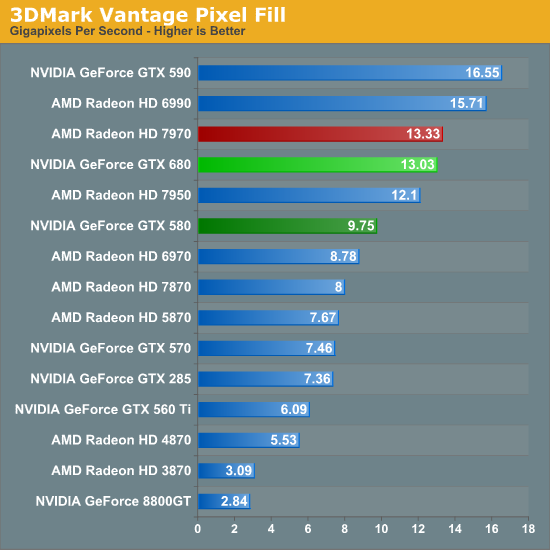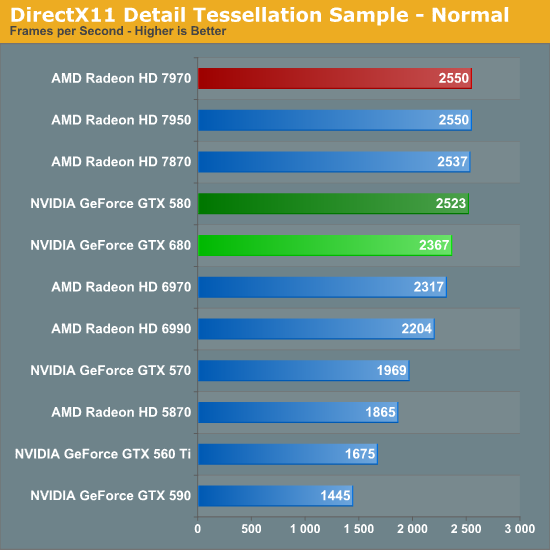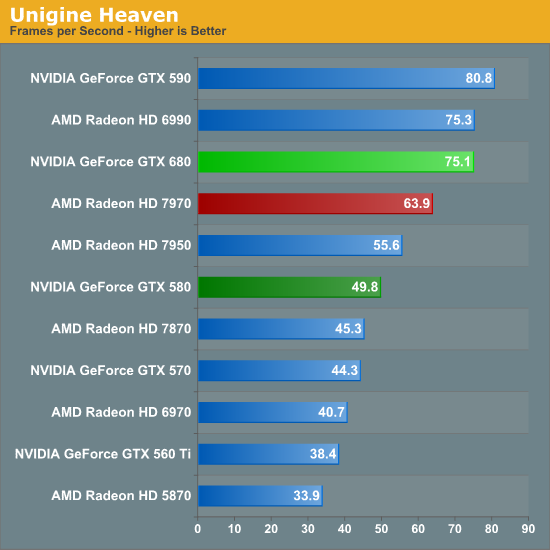NVIDIA GeForce GTX 680 Review: Retaking The Performance Crown
by Ryan Smith on March 22, 2012 9:00 AM ESTTheoreticals
As with any new architecture, we want to take a few moments to look at theoretical performance. These numbers shouldn’t be taken too seriously for cross-vendor comparison, but these numbers often tell us more about interesting architectural improvements that occur from one generation to the next.

Our first theoretical test is perhaps the most perplexing: 3DMark Vantage’s pixel fill test. Typically this test is memory bandwidth bound as the nature of the test has the ROPs pushing as many pixels as possible with as little overhead as possible, which in turn shifts the bottleneck to a mix of ROP performance and the memory bandwidth needed to feed those ROPs.
Compared to the GTX 580, the GTX 680 has almost exactly the same amount of memory bandwidth (192GB/sec) and only 86% of the theoretical ROP performance (37Gpix vs. 32Gpix). In short, it shouldn’t outperform the GTX 580 here, and yet it outperforms the 580 by 33%.
Why does it do this? That’s the hard thing to answer. As we mentioned in our look at GK104’s architecture, NVIDIA did make some minor incremental improvements to their ROPs coming from GF114, such as slightly improved compression and improved polygon merging. One of those may very well be the contributing factor, particularly the compression improvements since this is a typically memory bandwidth bottlenecked test. Alternatively, it’s interesting to note that the difference between the two video cards is almost identical to the difference in the core clock. GTX 560 Ti’s results tend to blow a hole in this theory, but it bears consideration.
In any case, it’s an interesting turn of events and hopefully one that isn’t simply an edge case. As we’ve seen in our benchmarks GTX 680 has strong performance – even if its lead compared to the 7970 diminishes with resolution – but compared to the GTX 580 in particular it needs strong ROP performance across all games in order to deliver good performance at high resolutions and anti-aliasing.

Our second theoretical test is 3DMark Vantage’s texture fill test, which to no surprise has the GTX 680 handily clobbering all prior NVIDIA cards. NVIDIA’s inclusion of 128 texture units on GK104 versus 64 on their previous generation GPUs gives the GTX 680 far better texturing performance. The 30%+ core clock difference only serves to further widen the gap.


Our third theoretical test is the set of settings we use with Microsoft’s Detail Tessellation sample program out of the DX11 SDK. Overall while NVIDIA didn’t make any significant changes to their tessellation hardware (peak triangle rate is still 4/cycle), they have been working on further improving performance at absurdly high tessellation factors. You can see some of this in action at the max factor setting, but even then we’re running into a general performance wall since the Detail Tessellation program can’t go to the absolute highest tessellation factors NVIDIA’s hardware supports.

Our final theoretical test is Unigine Heaven 2.5, a benchmark that straddles the line between a synthetic benchmark and a real-world benchmark as the engine is licensed but no notable DX11 games have been produced using it yet. In any case the Heaven benchmark is notable for its heavy use of tessellation, which means it’s largely a proxy test for tessellation performance. Here we can see the GTX 680 shoot well ahead of the GTX 580 – by more than we saw in the DX11 Detail Tessellation sample – but at the same time there’s a lot more going on in Heaven than just tessellation.
Honestly at this point in time I’m not sure just how much more tessellation performance is going to matter. Until DX11 is the baseline API for games, tessellation is still an add-on feature, which means it’s being used to add fine detail to specific models rather than being used on everything in a game world. This demands good tessellation at high factors but at the same time it’s subject to diminishing returns on the improvement to image quality as triangles reach single pixel sizes and smaller. To that end I’m still waiting to see the day where we see tessellation scale similarly to textures – that is by using full MIP chaining of displacement maps – at which point we can evaluate tessellation performance similar to texture performance when it comes to both measuring the performance hit and evaluating the difference in image quality.










404 Comments
View All Comments
chizow - Thursday, March 22, 2012 - link
Nvidia let AMD off the hook by productizing a mid-range GK104 ASIC as their flagship SKU and pricing it at $500.Its a great part no doubt and beats AMD in every metric, but as the article stated, its still going to be the smallest increase in price:performance that we've seen since 9800GTX.
Overall 28nm has been a huge disappointment so far in terms of performance increase over previous generations at the same price points, I guess we will have to wait for 28nm BigK to get that true high-end increase you'd expect from a smaller process node and new GPU arch.
B-Unit1701 - Thursday, March 22, 2012 - link
'Off the hook'? LMAO they released what they had. They are already months late, the only other option would have been to just not release a card this generation, would THAT have made you happier?chizow - Thursday, March 22, 2012 - link
No, what would have made me happier from both Nvidia and AMD would be to follow their own historical price:performance metrics.Instead, we have AMD first trying to pass an overall unimpressive Tahiti part as a high-end flagship at $550+ followed by Nvidia following suit by pricing their mid-range ASIC as a $500 part.
28nm has been a big disappointment so far, as we have the smallest increase in price:performance in any generation or process shrink since the 9800GTX.
CeriseCogburn - Thursday, March 22, 2012 - link
With AMD GF foundry failures TSMC is stoked to the gills. We're not going to get the prices you want for performance for another 6 months or so when production is freed up with TSMC's ongoing 2B expansion.You ought to include real inflation as well which is as we all know far higher than the socialist government figures that are suppressed so their automatic payout increases are lessened.
Be disappointed, a valid point, there are extenuating factors.
xrror - Thursday, March 22, 2012 - link
exactly. I completely understand why Nvidia is charging $500 for their mid-range part, but it still sucks.AMD also... I get why the 6000 series was gimped (it was originally supposed to be 32nm, and that fell through) but 7000 series... maybe that can be explained by moving to a new arch with GCN.
Regardless... disappointing. Well actually it's dissapointing that you must pay $500+ to get a card that /might/ give you a fresh gaming experience over the $350 card you bought last generation.
Unless AMD can pull a 8000 gen card out of their arse with drivers that work (i'm not optimistic) then you can bet if/when "full Kepler" comes out it will be $800+
CeriseCogburn - Friday, March 23, 2012 - link
Charlie D with his $299 leak, the only source, has made everyone think the 1core top card in the world was going to be released $150 cheaper than the current top 1core card in the world.He must still be laughing hard at semi-accurate.
chizow - Friday, March 23, 2012 - link
It wasn't Charlie's leak, it was the combined evidence of ~300mm^2 size, transistor count, mid-range specs, ASIC designation, and leaked GTX 670Ti pics also leading people to the conclusion this part was originally meant to be priced in that $250-$350 range.Obviously GK104 performed better than expected, coupled with Tahiti being weaker than expected, resulting in what we see today: an exceptionally performing mid-range ASIC being SKU'd as an overpriced flagship part at premium pricing.
CeriseCogburn - Tuesday, March 27, 2012 - link
Sorry I don't buy any of it. It's a "new architecture", if we take Charlie's leak, everything fits but the price, and every price has been $499 going on 4X in a row at least.chizow - Friday, March 23, 2012 - link
I agree, but honestly I don't even think AMD can compete at this point. Nvidia has beaten AMD at its own game soundly (small die, power efficient strategy, and done it with their 2nd best ASIC.Now they're free to make the slightly faster, power-hungry GPGPU monster GPU with as much TDP as they like without having to hear about it being worst than AMD's tree-hugging specs.
Sabresiberian - Friday, March 23, 2012 - link
Nvidia releasing their new architecture a few months after AMD released theirs does not make them late. Nvidia's schedule hasn't been the same as AMD's for several years now.And, what's AMD's answer to Big Kepler going to be? They lost today to Nvidia's mid-line chip, they will lose big time when Big Kepler comes out. By the time they catch up, Maxwell will be breathing down their necks.
;)